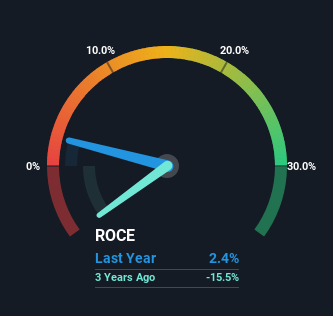- Hong Kong
- /
- Food and Staples Retail
- /
- SEHK:8413
The Returns On Capital At Asia Grocery Distribution (HKG:8413) Don't Inspire Confidence
When researching a stock for investment, what can tell us that the company is in decline? When we see a declining return on capital employed (ROCE) in conjunction with a declining base of capital employed, that's often how a mature business shows signs of aging. This indicates the company is producing less profit from its investments and its total assets are decreasing. So after glancing at the trends within Asia Grocery Distribution (HKG:8413), we weren't too hopeful.
Understanding Return On Capital Employed (ROCE)
For those that aren't sure what ROCE is, it measures the amount of pre-tax profits a company can generate from the capital employed in its business. The formula for this calculation on Asia Grocery Distribution is:
Return on Capital Employed = Earnings Before Interest and Tax (EBIT) ÷ (Total Assets - Current Liabilities)
0.024 = HK$2.6m ÷ (HK$132m - HK$27m) (Based on the trailing twelve months to March 2024).
Thus, Asia Grocery Distribution has an ROCE of 2.4%. In absolute terms, that's a low return and it also under-performs the Consumer Retailing industry average of 7.3%.
Check out our latest analysis for Asia Grocery Distribution

Historical performance is a great place to start when researching a stock so above you can see the gauge for Asia Grocery Distribution's ROCE against it's prior returns. If you want to delve into the historical earnings , check out these free graphs detailing revenue and cash flow performance of Asia Grocery Distribution.
What Does the ROCE Trend For Asia Grocery Distribution Tell Us?
There is reason to be cautious about Asia Grocery Distribution, given the returns are trending downwards. About five years ago, returns on capital were 4.3%, however they're now substantially lower than that as we saw above. On top of that, it's worth noting that the amount of capital employed within the business has remained relatively steady. Since returns are falling and the business has the same amount of assets employed, this can suggest it's a mature business that hasn't had much growth in the last five years. If these trends continue, we wouldn't expect Asia Grocery Distribution to turn into a multi-bagger.
On a side note, Asia Grocery Distribution's current liabilities have increased over the last five years to 20% of total assets, effectively distorting the ROCE to some degree. If current liabilities hadn't increased as much as they did, the ROCE could actually be even lower. Keep an eye on this ratio, because the business could encounter some new risks if this metric gets too high.
The Bottom Line
In the end, the trend of lower returns on the same amount of capital isn't typically an indication that we're looking at a growth stock. This could explain why the stock has sunk a total of 82% in the last five years. That being the case, unless the underlying trends revert to a more positive trajectory, we'd consider looking elsewhere.
If you'd like to know about the risks facing Asia Grocery Distribution, we've discovered 2 warning signs that you should be aware of.
While Asia Grocery Distribution isn't earning the highest return, check out this free list of companies that are earning high returns on equity with solid balance sheets.
New: Manage All Your Stock Portfolios in One Place
We've created the ultimate portfolio companion for stock investors, and it's free.
• Connect an unlimited number of Portfolios and see your total in one currency
• Be alerted to new Warning Signs or Risks via email or mobile
• Track the Fair Value of your stocks
Have feedback on this article? Concerned about the content? Get in touch with us directly. Alternatively, email editorial-team (at) simplywallst.com.
This article by Simply Wall St is general in nature. We provide commentary based on historical data and analyst forecasts only using an unbiased methodology and our articles are not intended to be financial advice. It does not constitute a recommendation to buy or sell any stock, and does not take account of your objectives, or your financial situation. We aim to bring you long-term focused analysis driven by fundamental data. Note that our analysis may not factor in the latest price-sensitive company announcements or qualitative material. Simply Wall St has no position in any stocks mentioned.
About SEHK:8413
Asia Grocery Distribution
An investment holding company, trades in and distributes food and beverage grocery products under Hung Fat Ho brand name in Hong Kong.
Flawless balance sheet with low risk.
Market Insights
Community Narratives





